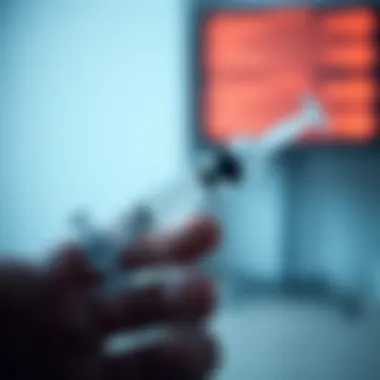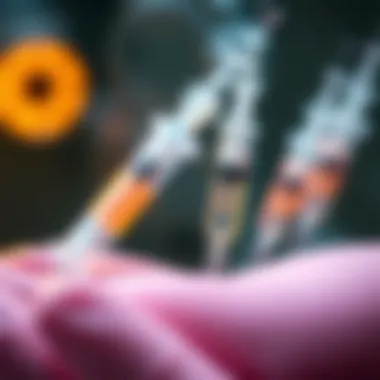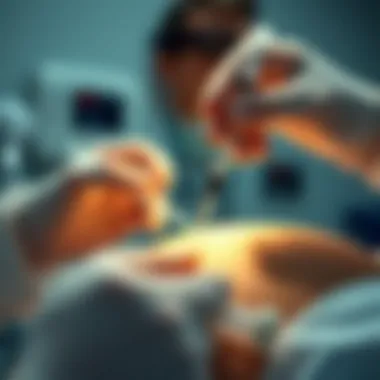Advancements in Needle-Free Syringe Technology


Overview of Research Topic
Brief Background and Context
Needle-free syringes, despite being a concept many might overlook, represent a significant leap in the evolution of medical delivery systems. Their journey began decades ago, rooted in the quest to minimize pain and anxiety associated with conventional injections. The idea is simple yet profound: delivering medications without the use of needles while maintaining efficacy and safety. This emerging technology has captured the attention of researchers and health professionals alike, as it seeks to tackle some of the persistent challenges in patient-centered care.
The mechanism behind needle-free syringes primarily relies on aplications of pressure for drug delivery, rather than the traditional hollow needle. This technology makes use of high-pressure jets to propel a liquid medication directly through the skin, enabling a swift and effective method for administering vaccines, insulin, and other critical treatments without the traumatic experience that needles cause for many.
Importance in Current Scientific Landscape
In today's healthcare landscape, where patient comfort and adherence are pivotal, the relevance of needle-free syringes cannot be overstated. With growing evidence suggesting that a significant percentage of individuals experience fear or anxiety related to needles—often referred to as trypanophobia—these syringes offer a solution that addresses such psychological barriers.
Furthermore, in the wake of global health crises, like the COVID-19 pandemic, the push for efficiency and safety in vaccine delivery has accelerated research and development in this area. There’s considerable potential for needle-free technology to change how vaccines are distributed, particularly in low-resource settings where traditional medical infrastructure is lacking. Even more, the implications for those who require frequent injections, such as diabetics, are profound and could lead to better health outcomes overall.
"The advent of needle-free technology not only revolutionizes the act of providing care, but also reshapes patient-doctor relationships to be more compassionate and understanding."
As researchers delve deeper into the possibilities that needle-free syringes present, we find ourselves at an intersection of innovation and practicality in healthcare. The ensuing sections aim to explore not only the technological advancements that underpin needle-free syringes but also their regulatory and ethical considerations as we stand on the cusp of what could very well be an injection revolution.
Preface to Needle-Free Technology
Needle-free technology represents a significant evolution in medical practice, designed with the intention of enhancing safety and comfort. As the landscape of healthcare changes, so too does the means by which patients receive essential therapies. When discussing needle-free syringes, we must consider their design, effectiveness, and the multiple ways they are being integrated into various treatment paradigms. This section delves into the intricacies of these innovations, setting the stage for a deeper understanding of their impact on patient care and overall health outcomes.
Overview of Traditional Syringe Usage
Traditional syringes have been the mainstay of medical administration for decades. They’ve allowed healthcare providers to deliver medications effectively, yet they are not without numerous drawbacks. The discomfort associated with needles can provoke anxiety in patients, particularly children. Sometimes, needle usage even causes healthcare providers themselves to have moments of hesitation, especially in community settings. Needle-stick injuries, which can have grave implications for both patients and practitioners, further complicate their safe application.
From a compliance standpoint, many individuals shy away from necessary treatments due to their fear of needles. A study has shown that approximately 25% of patients admit to avoiding injections, leading potentially to serious health consequences. The overall reliance on traditional syringes can create a barrier to effective healthcare delivery, sparking a demand for alternatives that can provide both efficacy and comfort.
The Emergence of Needle-Free Innovations
In response to these obstacles, needle-free technologies have surged forward, reshaping how medical procedures are conducted. These innovations aren’t just fads; they arise from rigorous research and development aimed at ensuring patient welfare and improving medical outcomes. Early iterations, such as jet injectors, initially made a splash, but today, more advanced options like microneedle arrays promise even greater effectiveness.
The technology harnessed in needle-free devices often utilizes high-pressure mechanisms or micro-sized needle points that puncture the skin without the conventional 'stick'. Such advancements minimize the pain associated with administration while significantly reducing the risk of environmental contamination or accidental needle-stick incidents.
Emerging studies indicate that with improved acceptance of these methods, patients tend to experience not only reduced anxiety but also better health management regimens. Therefore, the emergence of needle-free innovations signifies not just a technological progression but a broader paradigm shift toward more humane and efficient healthcare solutions. The road ahead suggests that overcoming challenges related to implementation and cost might pave the way for more widespread adoption.
Mechanisms of Needle-Free Syringes
Understanding the mechanisms behind needle-free syringes is vital to grasp their transformative role in modern medicine. These devices not only shift the approach to injections but also pave the way for better patient experiences. The intricate technology in these syringes addresses long-standing issues associated with traditional needles, such as pain, fear, and risk of infection. By delving into their operations and the various types available, we uncover how they enhance healthcare delivery and implications for broader medical practices.
Understanding the Delivery Mechanism
The crux of needle-free syringes lies in their ability to administer medication without penetrating the skin. This process typically involves a high-velocity jet or an array of tiny needles that create microchannels in the skin's surface.
An important characteristic of needle-free injections is their speed. The delivery mechanism can administer drugs in milliseconds, considerably reducing the time it takes to get a dose into the bloodstream. This efficiency not only minimizes discomfort but also ensures that patients experience less anxiety surrounding the injection process.
Moreover, the precision of these delivery systems allows for controlled dosages which maintains the efficacy of medications, particularly crucial in vaccination and chronic disease management. Thus, a deeper understanding of these mechanisms facilitates the exploration of their broader applications in healthcare.


Types of Needle-Free Devices
Needle-free syringes are not just one-size-fits-all; they come in various designs, each with distinct mechanisms suited for different applications. Two prominent types are jet injectors and microneedle arrays, each contributing uniquely to this burgeoning field of technology.
Jet Injectors
Jet injectors stand out due to their innovative approach to drug delivery. Utilizing a high-pressure stream, these devices force liquid medication through the skin without a needle. The main characteristic of jet injectors is their ability to administer various volumes of medication simultaneously. This flexibility makes them a preferred choice for vaccinations where multiple doses may be required in a single session.
One unique feature of jet injectors is their adjustable pressure settings, which allows for tailored delivery, depending on the viscosity of the medication. However, there are some drawbacks. Despite their efficacy, the speed at which they deliver medication may lead to discomfort in some patients. Furthermore, the technology's complexity can lead to higher costs, making it less accessible in low-resource settings. Nevertheless, their strengths in volume flexibility and speed affirm their place in needle-free technology.
Microneedle Arrays
Microneedle arrays offer a fascinating approach to drug administration. Unlike traditional needles, these devices consist of tiny microneedles that, despite their minuscule size, are capable of penetrating the upper layers of the skin with minimal pain. Their key feature is the array of microneedles, which can provide a uniform drug delivery over a larger area, enhancing the efficacy of medications.
The benefits of microneedle arrays extend to their potential in self-administration, making them a popular choice for chronic conditions like diabetes. Patients may prefer these devices due to reduced pain and easier usability. One disadvantage, however, is that they may not be suitable for all types of medications, particularly those requiring injection deep into tissues. Nonetheless, their growing use in both research and practical applications demonstrates the viability of microneedle arrays for advancing healthcare.
Exploring options like jet injectors and microneedle arrays shows how far we have come in patient-centric approaches to medication delivery in healthcare, sometimes requiring a shift in thinking from traditional practices.
Applications in Healthcare
Needle-free syringes are making waves in the medical world, bringing a fresh breath of innovation to various fields within healthcare. Their applications are multifaceted, helping to boost safety while enhancing patient comfort and compliance. With no needle involved, these syringes could very well be the key to future medical practices, especially in how we administer treatments and vaccinations. The significance of needle-free systems lies not just in their functionality; they represent a shift towards more patient-centric care, reducing fear and anxiety that many associate with traditional needles.
Vaccination Strategies
When it comes to vaccinations, needle-free syringes offer a unique advantage. On a global scale, the public's reluctance to receive vaccinations stems from fear of needles—often referred to as trypanophobia. By obviating this concern, needle-free devices could potentially increase vaccination rates, especially in children and adults who dread needles. Additionally, these syringes can facilitate mass vaccination campaigns. For example, during flu season, quick and painless delivery of vaccines might speed up the process, preventing overcrowding in clinics and ultimately helping to achieve herd immunity more efficiently.
"Needle-free vaccination not only eases the experience, but also opens doors for reaching populations in need without the usual resistance to needles."
Moreover, needle-free approaches like jet injectors can deliver vaccines at high speed and pressure, ensuring that the required dose is effectively administered under the skin. This can also reduce the amount of vaccine wasted, presenting a cost-effective solution in low-resource settings where every drop of vaccine matters.
Chronic Disease Management
Chronic diseases often require consistent management, which typically involves routine injections—think insulin for diabetes or biologics for rheumatoid arthritis. Here, needle-free syringes shine by dispelling the discomfort and inconvenience typically experienced with traditional injections. Patients are more likely to adhere to their treatment if they feel at ease with administration methods.
Importantly, some of the needle-free devices have mechanisms that allow for controlled, precise dosage. This is critical for chronic disease patients who need consistent levels of medication over time. With stress reduced from the needle aspect, many patients report feeling more empowered and less anxious about their daily care routine.
Pain Management
The realm of pain management has seen a quiet revolution with the introduction of needle-free technology. Traditional methods of drug delivery can be invasive and often painful, making them less desirable for patients. By integrating needle-free systems, healthcare providers can offer effective pain relief with minimal discomfort.
Many pain management plans can now incorporate more innovative delivery systems, such as using microneedle patches, which offer a 'prick' that is often undetectable. It’s as if the patient has been given a magic wand, paving the way for a more positive experience.
The versatility of these syringe alternatives also opens avenues for combining multiple medications in one easy-to-use device. Patients might find it easier to manage their regimens with fewer apprehensions.
Advantages of Needle-Free Syringes
The emergence of needle-free syringes has transformed how healthcare professionals approach the administration of medications. In this section, we’ll discuss the various advantages that these innovative devices bring to the table, shedding light on the positive impact they have for both patients and practitioners.
Reduced Needle-Related Anxiety


Needle phobia is a common issue among individuals, with studies suggesting that nearly 10% of adults experience significant anxiety when faced with needles. The apprehension surrounding injections often leads to avoidance of necessary medical treatment. Needle-free syringes, thanks to their painless and non-invasive delivery methods, can significantly diminish this anxiety.
For instance, a parent may feel dread every time their child requires an immunization. With the introduction of needle-free options, a simple press of a button can administer the vaccine, doing away with tears and worries. This not only eases the emotional burden on the patient but also on healthcare providers who must manage their patients' fears.
"By eliminating the fear of needles, needle-free syringes can encourage individuals to keep up with their vaccinations and regular check-ups."
Minimized Risk of Infection
In a traditional setting, the use of needles carries a risk of cross-contamination or infections from improper handling and disposal. Needle-free syringes help mitigate these risks, largely because they do not involve direct contact with the skin using a sharp object. Moreover, many newer devices utilize single-use mechanisms, ensuring that every administration is safe.
When you think about it, this is not just a minor detail. There's a tangible correlation between needle-related infections and healthcare costs. According to various health reports, the cost implications of treating infections due to needle use can be staggering. Hence, utilizing needle-free technology can enhance overall public health outcomes.
- Single-use systems help in maintaining strict hygiene standards.
- Reduced waste from discarded needles contributes to environmental sustainability.
Enhanced Patient Compliance
Patient compliance is a critical factor in successful treatment outcomes, especially for chronic conditions requiring regular injections, like diabetes. Research shows that fear of needles can detrimentally impact a patient's willingness to adhere to prescribed regimens.
Needle-free syringes present a more user-friendly alternative, encouraging patients to take their medication as directed. Imagine a diabetic patient who previously avoided insulin because the injections made them uneasy. With the availability of a needle-free option, they may be more inclined to maintain their treatment plan, leading to better health management.
Proper education about how these syringes work can further bolster compliance. When patients learn that they can manage their conditions without the anxiety connected to needles, the positive reinforcement can go a long way in encouraging regular treatment intervals.
While the advantages of needle-free syringes are indeed noteworthy, the discussion is incomplete without addressing the challenges in their implementation, which we will delve into next.
Challenges in Implementation
The excitement surrounding needle-free technology is certainly merited, yet the path to widespread adoption is fraught with challenges. Understanding these hurdles is crucial for researchers, healthcare professionals, and stakeholders who aim to harness the potential of needle-free syringes in real-world settings. Addressing the specific elements of this topic reveals the complexities involved that could influence not only the pacing of innovation but also the overall efficacy and acceptance of the devices within the healthcare system.
Technical Limitations
One of the significant barriers to implementing needle-free syringes revolves around their technical limitations. While these devices promise a pain-free alternative to traditional needles, they aren't without their shortcomings. For instance, some designs may struggle to deliver medication efficiently, especially in cases requiring precise dosages. The mechanisms behind jet injectors, for example, need to generate enough pressure to ensure medication reaches deep enough into muscle tissue. If the pressure isn’t optimal, the drug may not be absorbed as intended, affecting treatment outcomes.
Moreover, variability in patient physiology poses its own set of questions. Skin thickness, for instance, can greatly impact how and where a needle-free device delivers a substance. These challenges require continuous improvements and innovations in design and functionality.
Cost and Accessibility Issues
Another formidable obstacle is the financial aspect associated with these technologies. Generally regarded as innovative, needle-free syringes often come with a higher initial price tag compared to conventional needles and syringes. Budget-conscious healthcare facilities, particularly in lower-income regions, may find it challenging to justify the upfront costs. Furthermore, the production and maintenance expenses can contribute to hesitance in wider adoption. When hospitals and clinics weigh the long-term benefits against these costs, it can result in slow integration into standard practices.
The accessibility of needle-free options goes hand-in-hand with costs. Not every country or community has the resources to invest in such technologies, limiting their reach. Even in developed settings, distribution channels and supply chain issues may hinder availability.
Regulatory Hurdles
The regulatory landscape concerning needle-free syringes is another factor contributing to their slow uptake. Each country has its own set of guidelines that manufacturers must navigate, which can complicate efforts to bring new devices to market. For example, getting approval from bodies like the U.S. Food and Drug Administration isn’t just a walk in the park. It involves exhaustive clinical trials and documentation to ensure safety and efficacy, which takes time and resources. This process is vital, as public trust relies heavily on ensuring that these devices are thoroughly vetted.
The importance of rigorous regulatory scrutiny cannot be overstated; without it, the risks of adverse events could rise significantly, undermining patient confidence.
Additionally, some manufacturers may face inconsistencies in regulatory practices across different regions, causing challenges in global distribution. Combining the learning curves of developers with regulatory processes may lead to duration delays in bringing innovations to market.


In summation, while needle-free syringes hold remarkable promise for revolutionizing patient care and comfort, their pathway to implementation is riddled with technical, financial, and regulatory challenges. For stakeholders aiming to capitalize on this innovation, addressing these barriers will be critical to unleashing the full potential of this transformative approach to healthcare.
Future Perspectives in Needle-Free Technology
The field of needle-free technology is on the precipice of significant evolution. With the momentum gained over recent years, there are important prospects to consider, particularly regarding the enhancement of healthcare delivery. These innovations promise to reduce patient discomfort and improve treatment compliance, which is crucial in contemporary medical practices.
Innovative Research and Development
Innovative research in needle-free syringes is buzzing like bees in spring. New methodologies and technologies are being explored to improve upon existing designs. For instance, the development of biocompatible materials allows for syringes that are not only effective but also safer for patients. This involves creating delivery systems that can administer vaccines or medications more efficiently and with reduced adverse effects, thereby increasing their acceptability among the public.
Moreover, researchers are investigating ways to harness acoustic or ultrasonic waves to enhance the penetration of drugs through the skin without the need for needles. This approach utilizes sound waves to create temporary pores in the skin, allowing for rapid delivery of medication. It’s a promising avenue that could be game-changing for patient care.
Potential Expansions into Other Medical Areas
The applications of needle-free technology are like a canvas waiting for vibrant colors. Beyond traditional uses in vaccinations, there is significant potential to extend this technology into other areas of medicine. For example:
- Diabetes Management: Needle-free devices could provide an efficient means for insulin administration, particularly for those who dread needles.
- Oncology Treatments: Patients undergoing chemotherapy could benefit from needle-free delivery systems that minimize discomfort while providing vital medications necessary for their treatment.
- Biosensing Devices: Needle-free technology can work in tandem with biosensors. This could lead to non-invasive monitoring of glucose or blood components, revolutionizing how chronic conditions are managed.
These expansions not only improve patient comfort but could also broaden the reach of healthcare services to underserved populations, thereby enhancing equity in medical care.
Integration with Digital Health Solutions
In this tech-savvy age, the integration of digital health solutions is no longer an afterthought but a necessity. Needle-free syringes can be thoughtfully combined with mobile health applications and wearable devices to create a comprehensive patient management system. Imagine a scenario where:
- Monitoring occurs in real-time: Connected to health apps, needle-free syringes could track administration times, doses, and even patient reactions to medications.
- Data flows seamlessly: Healthcare professionals can have instant access to patients’ data, aiding in swift decision-making processes and personalized care plans.
- Patients actively engage: Through gamified apps, patients could be incentivized to adhere to their treatment schedules, enhancing their overall healthcare experience.
"The fusion of needle-free technology with digital health solutions can usher in a new era of healthcare, making treatment not just effective but also engaging for patients."
Closure: The Future of Needle-Free Syringes
The advent of needle-free syringes is more than just an incremental improvement in medical practice; it represents a significant shift in how we approach patient care and treatment methodologies. With a growing emphasis on comfort, safety, and efficiency in healthcare, these devices are carving a niche that could redefine patient interactions with medical treatments. Needle-free technology not only minimizes physical discomfort but also has the power to diminish fears and anxieties often associated with traditional syringes. This could ultimately lead to higher compliance rates, particularly in populations that are traditionally resistant to injections, such as children or individuals with a history of needle phobia.
Moreover, as vaccination campaigns strategize to reach wider demographics, needle-free syringes could facilitate a more rapid and effective rollout of immunization efforts. It's important to recognize the implication these advancements have not only on patient experience but also on healthcare systems' ability to deliver timely interventions.
Additionally, efficient needle-free systems provide the added benefit of reducing waste associated with sharps disposal, a consideration that can lead to more sustainable health care practices.
"The technology promises to make vaccines as easy as a spray for the nose, which is a game changer for public health efforts."
As we move forward, it is essential that healthcare professionals stay abreast of the latest advancements in needle-free technology and advocate for its adoption in clinical settings.
Summarizing the Impact on Healthcare
Needle-free syringes show a wide-ranging potential impact on healthcare, serving as a bridge to enhanced patient outcomes and streamlined treatment processes. Firstly, the reduced trauma associated with injections stands to improve psychological well-being, encouraging patients to seek necessary treatments without fear. Secondly, the potential for these devices to deliver medications swiftly and painlessly means that healthcare providers can improve their efficiency, allowing for quicker turnaround in administering treatments. Lastly, the integration of these technologies can significantly reduce extraneous costs, such as those associated with managing needle-related injuries or the disposal of sharps.
In essence, needle-free syringes symbolize an exciting frontier in the medical field that combines patient-centric design with forward-thinking practices, promising a future where healthcare is as non-invasive as possible.
Call to Action for Research and Development
With an eye toward the horizon, the ongoing research and development surrounding needle-free syringes should be accelerated. Addressing technical limitations and conducting longitudinal studies on patient outcomes could offer valuable insights into the practical application of these devices in everyday healthcare scenarios. Collaboration between engineers, researchers, and healthcare practitioners is crucial to create innovations that are not just user-friendly but also effective across a variety of clinical settings.
To facilitate growth in this field, funding and resources must be allocated toward empirical research that explores the full potential of needle-free syringes. Engagement with policymakers to streamline the regulatory pathways for these technologies will prove essential to their acceptance and widespread implementation.
In Summary
The commitment to developing needle-free technologies should be a priority focus for the medical community, both to improve patient experiences and to widen the scope of effective treatments available. As new innovations emerge, the dialogue surrounding their benefits and challenges can help shape the future of medical interventions. This is a call not just for acceptance but for active participation in the evolution of patient-centered healthcare solutions.



